“What’s something you find particularly confusing about Burgundy?”
Apparently there are a number of things to find confusing about this region: the classification system, land ownership, the varietal-less labels, gégociants. France‘s Burgundy stretches from Beaujolais in the south to Chablis in the north, although is not huge especially when compared with Bordeaux, producing only half as much wine.
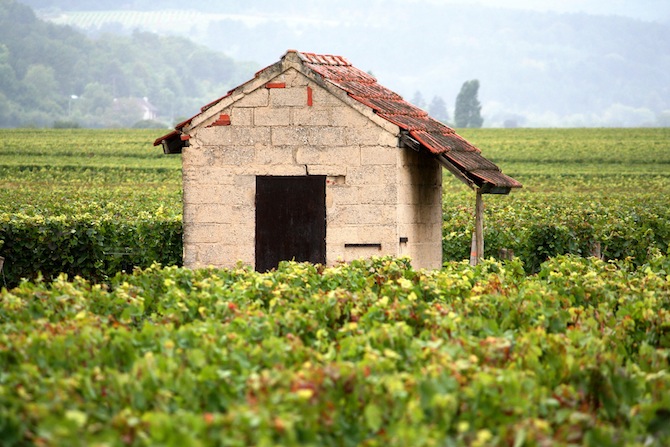
That being, it’s much more complex, with each village having it’s own appellation and certain vineyards having several owners. In Burgundy, the major wine regions, listed from north to south, include:
- Chablis, known for its dry white Chardonnay wines.
- The Côte de Nuits, showcasing 24 Grand Cru vineyards — which account for about 2% of Burgundy wines and are of the highest quality — and producing some of Burgundy’s best red wine
- The Côte de Beaune, famed for its rich Chardonnay, although they make some delicious reds that are meant to be aged.
- The Côte Chalonnaise, home to one of Burgundy’s grape exceptions — by law Burgandy wines are Pinot Noir and Chardonnay — Aligote. Although there are no Grand Cru vineyards here, it’s still known for producing some great wines.
- The Mâconnais is where you’ll find your value-driven wines. Not the best, but still good, and at a great price.
- Beaujolais is synonymous with Gamay, another one of Burgundy’s exception grapes. These wines are usually made using carbonic maceration, which leads to fruity wines low in tannins that are meant to be drank young. Interestingly it’s not actually part of Burgundy, the French administration includes it.
No discussion of Burgundy would be complete without also mentioning the Côte-d’Or, or “golden slopes,” home to some of the region’s most wallet-burning wines. Running 30 miles (48 kilometers) between Dijon and Santenay, it produces high-quality reds in its northern half and a mix of supreme reds and whites in its southern half.
The villages of the Côte-d’Or each have their own unique personality — due to the different terroirs — although almost all of the red wines from here are considered intense, chewy and earthy with a long finish. Whites from here typically showcase decadent flavors like truffle, vanilla and honey. Basically, if you have the chance to try a Côte-d’Or, do it.
How Is Burgundy Classified?
In order to differentiate the more than 100 appellations in Burgundy, a classification system exists that separates them into four different categories:
- Regional Wines, which don’t necessarily mean the wine isn’t high quality, just that the grapes can come from anywhere in Burgundy.
- Village Wines are a step up from Regional Wines, as they’re a bit more complex. They’re named after the nearby villages.
- Premier Cru wines come next, also named after nearby villages but with grapes sourced from special vineyards called climats. These vineyards have great soil and produce wines that are more intense than Village Wines.
- Grand Cru refers to the crème de la crème of Burgundy wines. The names of these crus come from the vineyard itself. Grand Crus make up less than 2% of Burgundy wines — there are 33 Grand Cru vineyards total in the region — so if you’re offered a taste — especially on someone else’s dime — do it.
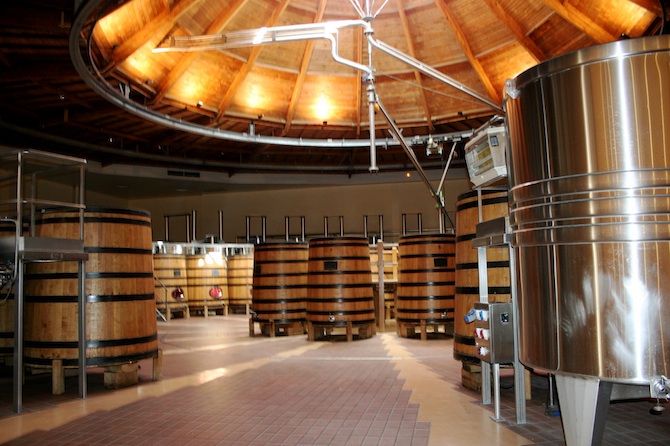
Louis Jadot wine barrels. Photo courtesy of Megan Mallen.
Chateaus vs Domaines
One concept that’s important to understand when talking about Burgundy is chateaus vs domaines. While people often use these words interchangeably, the truth is they are different. A chateau would be used to refer to a single estate surrounded by vineyards. On the other hand, a domaine is when a single winemaker owns small parcels of vineyards scattered around different villages and appellations, allowing for an array of options when it comes time to harvest the grapes and make the wine. Burgundy’s best wines are typically domaine wines. Chateau is usually a word referring to Bordeaux, and domaine is usually a word referring to Burgundy.
Négociants, or wine brokers, also also important to understand. These people were once seen as “bad guys” who held all the power in what wine got sold and how much winemakers would make, as small winemakers needed the help of these people to bottle, market and sell their wine.
These négociants would buy wine from the little guys, blend it together and sell it as their own. Today, however, it’s a bit different. In the 1960s power began to shift as small winemakers began bottling and selling their wine under their own brand. Because there was little left for the négociants to buy, they were then forced to make their own wine. Today, négociant houses typically own many vineyards across numerous appellations, although with the exception of a few the best Burgundy wines are believed to come from the smaller domaines.

Wine grapes. Photo courtesy of Noel Zia Lee.
Burgundy Grapes
Let’s move on to talking about what’s not confusing about Burgundy: the grapes. By law, only two grapes are permitted in Burgundy, Chardonnay for white and Pinot Noir for red, with a few exceptions (Gamay for Beaujolais and Aligote for Bourgogne Aligote).
For those who are used to the bold and powerful Pinot Noirs of California and the New World, you probably won’t quite get Burgundy Pinot Noirs right away. It’ll take time for you to appreciate the subtle aromas, textures and elegance. To some the wine might seem ” wimpy” at first, which is what makes wine education so important. It allows you to appreciate the subtle nuances that have the potential to really amaze your palate. More than any other wines in the world, Burgundy wines are sensual and emotional.
Keep in mind, Pinot Noir is a thin-skinned, light grape that naturally produces light wine with finesse; however, in many New World regions the restrictions are more lax in what is deemed a Pinot Noir. In fact, in California a wine needs only 75% Pinot Noir to be labeled as such. This means winemakers can add wines like Syrah and Cabernet Sauvignon to create darker colored, higher alcohol and more full bodied wines; however, as Mr. Ross states “wine is meant to be drank, not sipped,” which is what a light Burgundy Pinot Noir allows for.
Moreover, Burgundy wines are known for being made to pair with food. The winemakers here aren’t focusing on creating a fruit bomb or overpowering your palate with sweetness; but creating wines that enhance your dining experience.
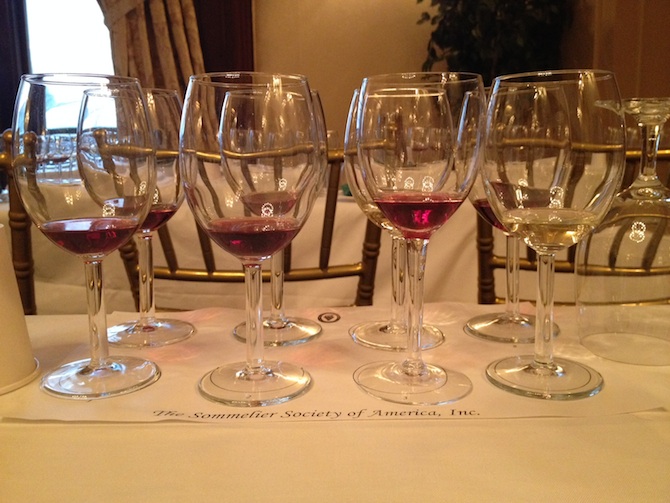
Pinot Noir
A tasting of a variety of Burgundy Pinot Noirs allows us to not only experience the delicate characteristics of this wine, but also the benefits of aging.
We begin with a 2011 Vignerons de Mancey Bourgogne Rouge, made at a cooperative where winemakers share resources to lower production costs. This wine goes for about $15-$20 a bottle, making it one of the more budget-friendly options. My first impression was that it has a lighter hue than what you’d see in California, although, as Mr. Ross reminded us, color doesn’t necessarily mean a wine won’t have flavor and fragrance. In fact, it was very fragrant with red berries on the nose. On the palate it was low in tannins as well as subtle and austere which, when combined with the high acidity cleansed the palate and made it ready for food.
Next we sample a wine with a bit more intensity — as well as a bit more pricey at $25-$35 per bottle — a 2009 Domaine Desertaux-Ferrand Cote de Nuits-Villages “Les Perrieres.” This wine comes from one four villages by law that are known for their high quality. On this wine I got some under-ripe fruit as well as some earthy, rustic notes. Not surprisingly, the wine was also great for food pairing, flavorful and fragrant without stealing the show.
The next wine was a 2010 Domaine Thierry et Pascale Matrot Santnots from the Volnay appellation in the Cote de Beaune, which is highly regarded. This $46 bottle of wine had a stony fragrance, high acid and was dry. It is meant to be aged, and its closed, rugged nature told us we’d drank it a bit too soon (as a wine ages it’s tannins soften). According to Mr. Ross, “The materials are there, it will just take time.”

Fermenting Pinot Noir. Photo courtesy of Stefano Lubiana.
Our next Pinot Noir was one of the more interesting tastings as it showed us how “Pinot Noir dies gracefully.” It was a 2007 Paul Pillot Santenay Vieilles Vignes, and had beautiful brown edges from the bottle aging.
The wine was a little musty, and less bright than the young wines the class tasted before. It was also apparent how the balance had shifted during the aging process, with less body, more pronounced tannins and a more rustic feel. According to Mr. Ross, when the wine was young it was probably less astringent, as the tannins would have been complemented by the young fruit and bouquet.
Our final Pinot Noir tasting was a Michel Sarrazin & Fils Givry “Sous la Roche” from the Cote Challionaise, one of the best regions for value-friendly Burgundy wines. After smelling the wine, Mr. Ross informed the class that the closed bouquet was consistent with the 2010 vintage.
That being said, for me this was the most mind-blowing wine of them all due to the velvet mouthfeel. While I’ve heard people talk about wines as being “velvety” before, I’ve never quite understood what they meant. This wine made me a believer that there are wines out there that can literally caress your palate. It was also sweet, very concentrated and had flavors of juicy plum. Not surprisingly it was Domain-bottled.
Side note: “Vieilles Vignes” means “old vines,” and is a cause of contempt for many winemakers. This is because in Burgundy there is no minimum age a vine must be to be considered old. Because old vines are typically better — they have longer root systems which allow for more access to water and produce smaller grapes that have more skin — it’s sometimes used simply as a marketing tactic. That being said, this bottle is worth its $40 price tag.
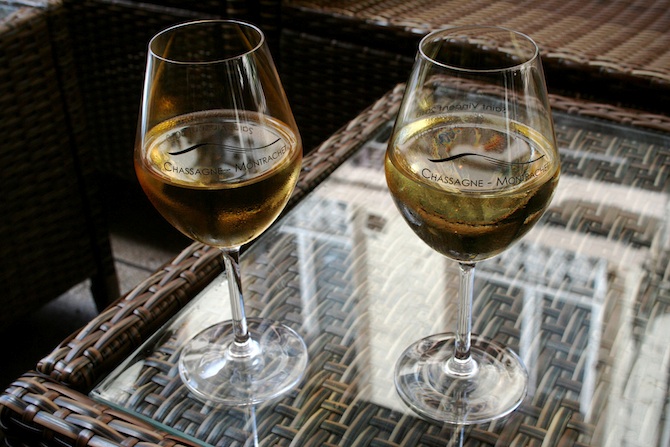
Burgundy’s Beaune wine. Photo courtesy of Megan Mallen.
Chardonnay
The Chardonnays of Burgundy are also most likely not what you would expect. During the class we tried two different types of Chardonnay. The first was a 2011 Louis Latour Chassagne-Montrachet, a lean wine aged for about eight months in oak then sold for $50 per bottle. Louis Latour is also a cooper, and is known for crafting some of the world’s top wine barrels.
We compared that to a 2011 Cave des Vignerons de Mancey Macon white Burgundy that had a floral nose and fruit taste, meant to be drank young. It was a bit more flamboyant from the previous wine, and very budget-friendly at under $15 per bottle.
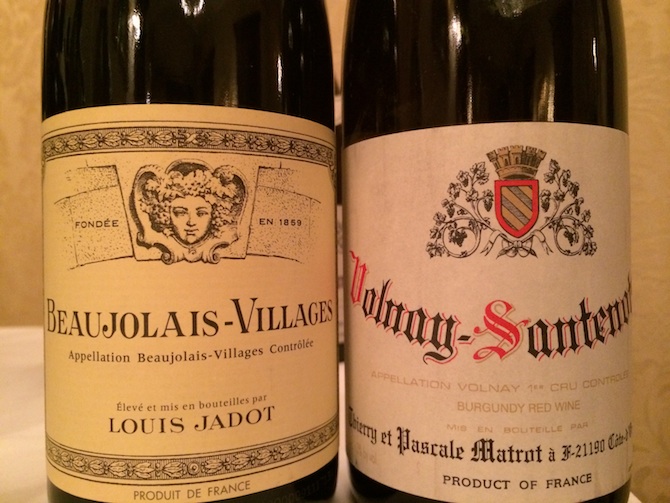
Beaujolais and Volnay-Santenots. Photo courtesy of Betty Pallis, the Senior Program Coordinator of the Sommelier Society of America.
Beaujolais
To experience Beaujolais, we sampled this region through a 2011 Louis Jadot Beaujolais-Villages made with the Gamay grape — one of Burgundy’s exceptions to the Pinot Noir and Chardonnay-only rule. The wine was a little coarse on the nose, although some bottle aging would clear that up. It was also a little chewy on the palate, a common finding for Beaujolais.
Top photo Burgundy, France. Photo courtesy of Megan Mallen.

Jessica Festa is the editor of the travel sites Jessie on a Journey (http://jessieonajourney.com) and Epicure & Culture (http://epicureandculture.com). Along with blogging at We Blog The World, her byline has appeared in publications like Huffington Post, Gadling, Fodor’s, Travel + Escape, Matador, Viator, The Culture-Ist and many others. After getting her BA/MA in Communication from the State University of New York at Albany, she realized she wasn’t really to stop backpacking and made travel her full time job. Some of her most memorable experiences include studying abroad in Sydney, teaching English in Thailand, doing orphanage work in Ghana, hiking her way through South America and traveling solo through Europe. She has a passion for backpacking, adventure, hiking, wine and getting off the beaten path.








